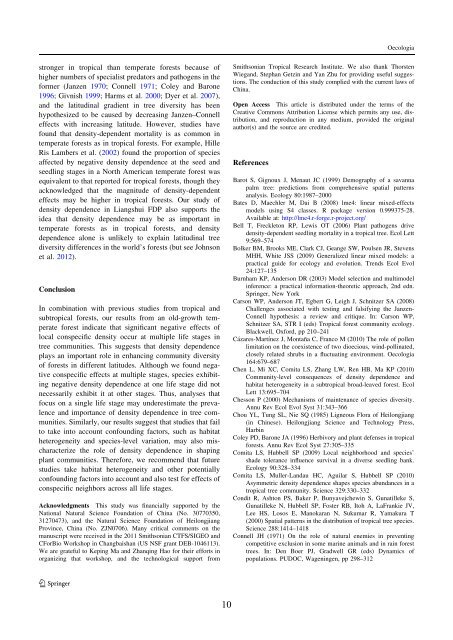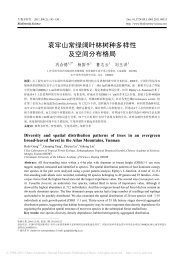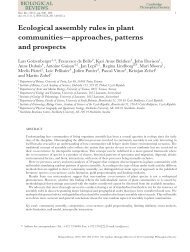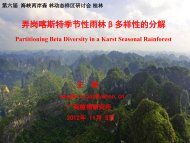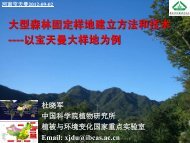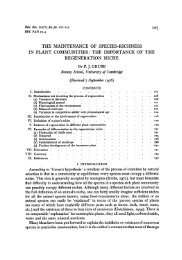Contents - ä¸å½æ£®æçç©å¤æ ·æ§çæµç½ç»
Contents - ä¸å½æ£®æçç©å¤æ ·æ§çæµç½ç»
Contents - ä¸å½æ£®æçç©å¤æ ·æ§çæµç½ç»
- No tags were found...
Create successful ePaper yourself
Turn your PDF publications into a flip-book with our unique Google optimized e-Paper software.
Oecologiastronger in tropical than temperate forests because ofhigher numbers of specialist predators and pathogens in theformer (Janzen 1970; Connell 1971; Coley and Barone1996; Givnish 1999; Harms et al. 2000; Dyer et al. 2007),and the latitudinal gradient in tree diversity has beenhypothesized to be caused by decreasing Janzen–Connelleffects with increasing latitude. However, studies havefound that density-dependent mortality is as common intemperate forests as in tropical forests. For example, HilleRis Lambers et al. (2002) found the proportion of speciesaffected by negative density dependence at the seed andseedling stages in a North American temperate forest wasequivalent to that reported for tropical forests, though theyacknowledged that the magnitude of density-dependenteffects may be higher in tropical forests. Our study ofdensity dependence in Liangshui FDP also supports theidea that density dependence may be as important intemperate forests as in tropical forests, and densitydependence alone is unlikely to explain latitudinal treediversity differences in the world’s forests (but see Johnsonet al. 2012).ConclusionIn combination with previous studies from tropical andsubtropical forests, our results from an old-growth temperateforest indicate that significant negative effects oflocal conspecific density occur at multiple life stages intree communities. This suggests that density dependenceplays an important role in enhancing community diversityof forests in different latitudes. Although we found negativeconspecific effects at multiple stages, species exhibitingnegative density dependence at one life stage did notnecessarily exhibit it at other stages. Thus, analyses thatfocus on a single life stage may underestimate the prevalenceand importance of density dependence in tree communities.Similarly, our results suggest that studies that failto take into account confounding factors, such as habitatheterogeneity and species-level variation, may also mischaracterizethe role of density dependence in shapingplant communities. Therefore, we recommend that futurestudies take habitat heterogeneity and other potentiallyconfounding factors into account and also test for effects ofconspecific neighbors across all life stages.Acknowledgments This study was financially supported by theNational Natural Science Foundation of China (No. 30770350,31270473), and the Natural Science Foundation of HeilongjiangProvince, China (No. ZJN0706). Many critical comments on themanuscript were received in the 2011 Smithsonian CTFS/SIGEO andCForBio Workshop in Changbaishan (US NSF grant DEB-1046113).We are grateful to Keping Ma and Zhanqing Hao for their efforts inorganizing that workshop, and the technological support fromSmithsonian Tropical Research Institute. We also thank ThorstenWiegand, Stephan Getzin and Yan Zhu for providing useful suggestions.The conduction of this study complied with the current laws ofChina.Open Access This article is distributed under the terms of theCreative Commons Attribution License which permits any use, distribution,and reproduction in any medium, provided the originalauthor(s) and the source are credited.ReferencesBarot S, Gignoux J, Menaut JC (1999) Demography of a savannapalm tree: predictions from comprehensive spatial patternsanalysis. Ecology 80:1987–2000Bates D, Maechler M, Dai B (2008) lme4: linear mixed-effectsmodels using S4 classes. R package version 0.999375-28.Available at: http://lme4.r-forge.r-project.org/Bell T, Freckleton RP, Lewis OT (2006) Plant pathogens drivedensity-dependent seedling mortality in a tropical tree. Ecol Lett9:569–574Bolker BM, Brooks ME, Clark CJ, Geange SW, Poulsen JR, StevensMHH, White JSS (2009) Generalized linear mixed models: apractical guide for ecology and evolution. Trends Ecol Evol24:127–135Burnham KP, Anderson DR (2003) Model selection and multimodelinference: a practical information-theoretic approach, 2nd edn.Springer, New YorkCarson WP, Anderson JT, Egbert G, Leigh J, Schnitzer SA (2008)Challenges associated with testing and falsifying the Janzen-Connell hypothesis: a review and critique. In: Carson WP,Schnitzer SA, STR I (eds) Tropical forest community ecology.Blackwell, Oxford, pp 210–241Cázares-Martínez J, Montaña C, Franco M (2010) The role of pollenlimitation on the coexistence of two dioecious, wind-pollinated,closely related shrubs in a fluctuating environment. Oecologia164:679–687Chen L, Mi XC, Comita LS, Zhang LW, Ren HB, Ma KP (2010)Community-level consequences of density dependence andhabitat heterogeneity in a subtropical broad-leaved forest. EcolLett 13:695–704Chesson P (2000) Mechanisms of maintenance of species diversity.Annu Rev Ecol Evol Syst 31:343–366Chou YL, Tung SL, Nie SQ (1985) Ligneous Flora of Heilongjiang(in Chinese). Heilongjiang Science and Technology Press,HarbinColey PD, Barone JA (1996) Herbivory and plant defenses in tropicalforests. Annu Rev Ecol Syst 27:305–335Comita LS, Hubbell SP (2009) Local neighborhood and species’shade tolerance influence survival in a diverse seedling bank.Ecology 90:328–334Comita LS, Muller-Landau HC, Aguilar S, Hubbell SP (2010)Asymmetric density dependence shapes species abundances in atropical tree community. Science 329:330–332Condit R, Ashton PS, Baker P, Bunyavejchewin S, Gunatilleke S,Gunatilleke N, Hubbell SP, Foster RB, Itoh A, LaFrankie JV,Lee HS, Losos E, Manokaran N, Sukumar R, Yamakura T(2000) Spatial patterns in the distribution of tropical tree species.Science 288:1414–1418Connell JH (1971) On the role of natural enemies in preventingcompetitive exclusion in some marine animals and in rain foresttrees. In: Den Boer PJ, Gradwell GR (eds) Dynamics ofpopulations. PUDOC, Wageningen, pp 298–31212310


